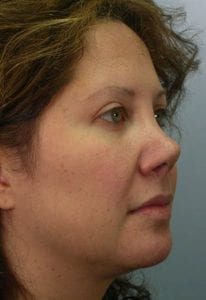
How Can Rhinoplasty Fix the Bridge of the Nose?
Many people consider rhinoplasty to fix problems with the bridge of their nose. In this case, a small change to the bridge of your nose can have a huge impact on your appearance. Since the nose is the most prominent feature on the face, when it is out of balanced with the rest of your facial features, it can take away some of the pleasing aesthetic of your face.
What are Common Issues with the Bridge of the Nose?
There are several reasons the bridge of the nose might benefit from Rhinoplasty.
Congenital Issues and Saddle Nose
Low bridge nose deformity presents as a somewhat scooped out or concave area where the bridge of the nose (the dorsal). This is referred to as a “saddle nose” as it resembles the slope of a horse’s saddle. Most low bridge issues are a result of surgery or injury during the developmental stage while the nose is still growing, resulting in a nose that is turned up with a low bridge. Also, it is possible to sustain an injury later in life where the septum loses support. This occurs in the mid structure between the two mucoperichondrial flaps as the tissue dissolves the bridge of the nose causing the nose to lose support and drop.
Overzealous Rhinoplasty and Saddle Nose Issues
And finally, one of the more common causes of a saddle nose is over aggressive or zealous surgery which takes down the dorsal or low bridge of the nose too much leaving the nose looking scooped out or swayed. In addition, there are also some other related cosmetic features that are not desirable. For example: when the nose has been brought down too far it creates the illusion of a wide angle between the tip and the lip. This is called the nasolabial and when that angle is widened it gives the illusion that the nose is turned up or piggy-like. So, the first step in evaluating the patient with a low bridge or scooped out nose is to look at the entire nose in its aesthetic proportion to not only look at the dorsal bridge but at the length of the nose (defined by the distance from the radix to the tip) and all its other angles.
How Do You Build Up the Sloping Nose?
There are a couple of ways to build up the bridge and both of which require implanting cartilage or other material. Some surgeons will use a material like Gore-tex® or other similar materials currently on the market to build up the bridge. We have done that over the past 25 years for rhinoplasty however that is not my first choice. While we have had good results in our patients with these materials, there are a small percentage of patients who ultimately and eventually reject the implant resulting in it coming out – the medical term for this is extrusion. There is also a possibility that the implant becomes infected and although it only occurs in 5-7% of patients that number is still too high in my opinion. For that reason, we prefer the patient’s own tissue or cartilage. There are basically a few different cartilage sources – the first being the septum cartilage, the second ear or contra cartilage, and the third source being rib cartilage. The cartilage can either be used in a structural fashion as spreader grafts and then as an on lay graph on top of the bridge or simply an on lay graph depending on the severity. Some patients who have had previous rhinoplasty also have a very short nose so the nose needs to be lengthened and the only way this can be done to build structure not only on the bridge of the nose but on the caudal or lower end of the nose bringing the nose down to a more natural position. This is typically done with spreader grafts and what is referred to caudal extension graft. In our hands, two caudal extensions work best to get the appropriate amount of counter rotation necessary for lengthening the nose.
Additionally, we find that rib or costal cartilage is the best choice in all areas because of it is abundant so we can harvest as much as is necessary. Ear cartilage is good for small on laid graphs or contra irregularities but typically does not work well when structure is really needed. The other option is septum cartilage. Unfortunately, a lot of patients who have had previous rhinoplasty taking cartilage from the septum leave them with inadequate septum cartilage for reconstructive surgery.
I hope this answers some of your questions on how to build up the bridge of a weak nose (saddle nose). Check out our website or videos on rhinoplasty and revision rhinoplasty.
